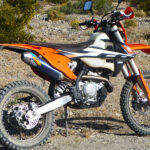Finding the ideal bike lock can be a challenge, given the vast array of options available. Making the wrong choice could lead to devastating consequences – the theft of your bicycle. The key to effective bike security lies in selecting a lock that is not only robust enough to deter thieves but also practical for your daily use. This crucial balance between security and usability is paramount. As someone deeply involved in testing and writing about bicycle security since 2015, I understand the nuances of choosing the right lock.
Below, I recommend 6 of the best Bike Locks currently on the market, chosen for their security level and performance in user testing. If none of these perfectly suit your needs, don’t worry. Following these recommendations, I will guide you through three simple steps – including a quick risk assessment quiz – to ensure you find the perfect bike lock for your specific requirements.
1. Litelok X1: The Top All-Around Bike Lock
The Litelok X1 stands out as the best all-round bike lock in 2024. Its exceptional feature is providing genuine protection against cordless angle grinder attacks, a rising threat in bike theft. Currently, it remains the only angle grinder resistant bike lock that effectively balances high security with everyday usability and reasonable pricing, making it ideal for cyclists needing superior protection.
Angle grinder attacks are becoming increasingly prevalent, particularly in urban areas, often becoming the preferred method for thieves targeting bikes secured with less substantial cable locks. Until recently, no bike lock could withstand an angle grinder for more than a minute. Locks like the Litelok X1 and the Hiplok D1000, capable of resisting these attacks, are therefore critically important.
 Litelok X1 on front wheel
Litelok X1 on front wheel
Litelok X1: the best all round bike lock for superior bicycle security.
What distinguishes the Litelok X1? It maintains the familiar form and function of a standard u-lock, with a minimal size difference of less than 2 cm in length, ensuring no practical compromise in usability. The key innovation lies in the ceramic composite material fused to its 16 mm shackle. This advanced material effectively degrades angle grinder discs as they attempt to cut through the lock.
Litelok X1: Recognized as a top-tier, high-security bike lock for reliable theft prevention.
| Litelok X1 |
|---|
| My score: |
| Check price: |
| Shackle thickness: |
| Weight: |
| Size (internal): |
| Other Security Ratings: |
In my comprehensive tests, cutting through just one side of the Litelok X1 took over four times longer than the Kryptonite New York Fahgettaboudit, previously considered the most secure bike lock. In fact, during the initial test, all available cutting discs were exhausted before completely severing even one side of the Litelok X1.
The Litelok X1’s impressive performance is widely recognized. It is one of the select few bike locks to achieve a Sold Secure Powered Cycle Diamond rating, a testament to its superior security.
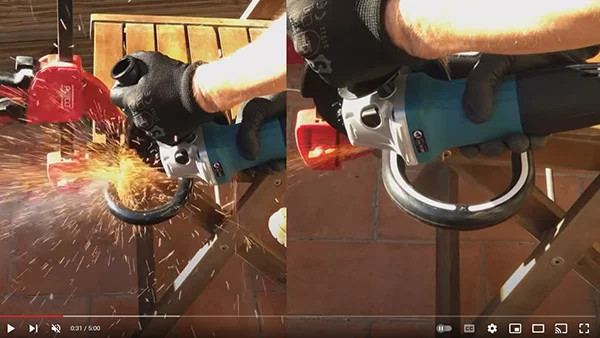 Litelok X1 test video still
Litelok X1 test video still
Watch a video demonstration of the Litelok X1 resisting an angle grinder attack, showcasing its robust bike security features.
Is the Litelok X1 flawless? Not entirely. Initially, locking my Litelok X1 was slightly cumbersome, although a simple DIY solution quickly resolved this, and the manufacturer has since addressed this issue. More importantly, it is not as impenetrable as the Hiplok D1000 (and DX1000), or the Litelok X3, which demonstrated 2.5 and 3 times greater resistance to cutting, respectively, in my tests.
So, why isn’t the Hiplok D1000 or Litelok X3 my top recommendation for 2024? While undeniably robust and currently the strongest bike locks available, they come with significant drawbacks. Both are considerably more expensive and heavier than the Litelok X1, and less convenient to carry. Furthermore, the Hiplok D1000’s smaller size (addressed in the Hiplok DX1000) might not suit all cyclists.
[ Litelok X1 vs Litelok X3 vs Hiplok D1000]
Litelok X1 vs Litelok X3 vs Hiplok D1000]
Comparison of Litelok X1, Litelok X3, and Hiplok D1000 bike locks, highlighting differences in size and security.
The Litelok X1 strikes an optimal balance of security, usability, and cost. Its practical size, efficient frame mount, and competitive price – only marginally more expensive than the Abus Granit X Plus 540 and half the price of the Hiplok D1000 – position it as the most sensible choice for most cyclists seeking angle grinder resistance.
For a deeper dive, read my comprehensive Litelok X1 review, including an angle grinder resistance comparison video with the Fahgettaboudit, or my Litelok X1 vs Hiplok D1000 comparison. Stay updated on new angle grinder resistant bike locks by visiting my page dedicated to angle grinder proof bike locks.
2. Kryptonite Kryptolok New-U: Excellent Medium Security
Not every cyclist requires angle grinder resistance. I encourage you to take my brief 3-question quiz to assess your risk level and determine if angle grinder protection is necessary for you. For those who don’t need such extreme security, the Kryptonite Kryptolok New-U, an enhanced version of the well-regarded Kryptolok Series 2, offers a fantastic, affordable alternative for securing your bicycle.
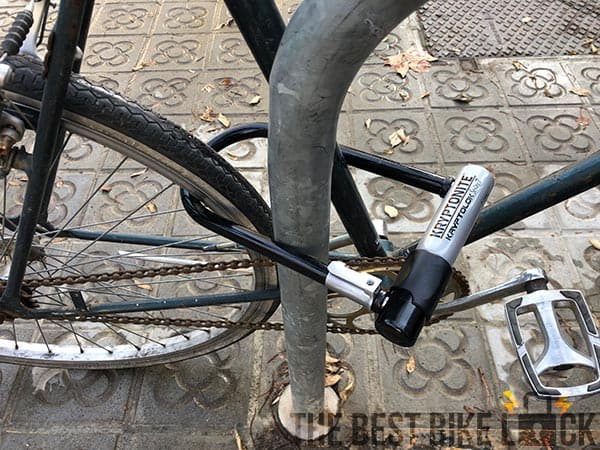 Kryptonite Kryptolok Standard: best medium security bike lock
Kryptonite Kryptolok Standard: best medium security bike lock
Kryptonite Kryptolok Standard: A top-rated medium security bike lock, providing reliable protection for everyday cycling.
By upgrading the shackle to lock on both sides, the Kryptolok New-U has achieved a Sold Secure Gold rating, up from Silver. However, maintaining a 2/5 star ART rating indicates it remains a medium-security lock. The appeal of the Kryptolok lies in its ease of use. It is lightweight, comparable to 3.5 cans of soda, and conveniently portable when using the correctly fitted frame mount. Its generous size simplifies securing your bike in various locations.
 Kryptonite Kryptolok New-U best mid-security lock
Kryptonite Kryptolok New-U best mid-security lock
Kryptonite Kryptolok New-U: Recognized as a best mid-security bike lock, offering a balance of protection and practicality.
| Kryptonite Kryptolok New U |
|---|
| My score: |
| Check price: |
| Shackle thickness: |
| Weight: |
| Size (internal): |
| Kryptonite rating: |
| Other Security Ratings: |
While I prefer the keyhole covers found on OnGuard locks, which seem to improve disc alignment, this is a minor issue, especially since OnGuard mechanisms are generally less secure. Kryptonite’s customer service is exceptional, offering benefits like free key replacements and reduced-price (or free) lock replacements under certain conditions.
For enhanced security within the Kryptonite range, consider their Evolution series. However, these are heavier or smaller and still lack angle grinder resistance. For lower-risk scenarios, the Kryptonite Kryptolok provides an easy-to-use, adequately protective, and reasonably priced bike lock.
Read my detailed, hands-on review of the Kryptolok for more insights and alternative suggestions if this lock isn’t the right fit for you.
3. Foldylock Compact: The Lightest Secure Folding Lock
Folding locks are gaining popularity as bike security solutions due to their portability and versatile locking options. However, many lack adequate security, making recommendations selective. The Foldylock Compact stands out as the lightest folding lock that still offers a commendable level of protection, achieving a Sold Secure Silver rating. Among folding locks tested, it is also the most user-friendly.
 Foldylock Compact: lightest folding lock
Foldylock Compact: lightest folding lock
Foldylock Compact: Acclaimed as the lightest folding bike lock, perfect for cyclists prioritizing portability.
The Foldylock Compact, at 33 inches (85 cm) in length, provides a similar internal locking space to a standard u-lock. Its flexible design offers more versatility in securing your bike to various objects. Weighing just 2.2 lb (1 kg), it’s comparable to 2.5 cans of soda. For even greater lightness, a shorter 75 cm version is available, including a belt clip option forgoing the need for a frame mount.
Foldylock Compact: Shows its compact and convenient design, ideal for easy storage and transport on bikes.
| Foldylock Compact |
|---|
| My score: |
| Check price: |
| Plate thickness: |
| Weight: |
| Length: |
| Foldylock rating: |
| Other Security Ratings: |
Compared to its closest competitor, the Abus Bordo 6000 (until the Abus lost its Sold Secure Silver rating), the Foldylock Compact is lighter and easier to use. It unlocks and unfolds more smoothly, offers better bike maneuverability, and includes a superior frame mount, often at a lower price. Check Amazon for current pricing.
If you’re in a lower-risk area and need a compact, flexible, and lightweight alternative to a u-lock, the Foldylock Compact is an excellent choice. Read my hands-on review of the Foldylock Compact for more details and alternative suggestions if it doesn’t meet your needs. You can also explore more lightweight bike locks.
4. Foldylock Forever: High-Security Folding Lock
Foldylock also offers the Foldylock Forever, a high-security folding lock that’s a robust, heavy-duty version of their standard models like the Classic, Compact, and Mini.
 Foldylock Forever around traffic light
Foldylock Forever around traffic light
Foldylock Forever: Demonstrates its extended reach and flexibility by securing a bike to a traffic light, a feat impossible for many u-locks.
Slightly longer than the Foldylock Compact at 35.4″ (90 cm), it provides ample locking options, easily fitting around larger objects like traffic lights, which would be impossible for a u-lock. More significantly, its arms are 6.5 mm thick, compared to 5 mm on standard Foldylocks. This extra thickness contributes to its Sold Secure Gold rating, a step up from the Silver rating of other Foldylocks.
The Foldylock Forever’s arms are also 1 mm thicker than other Sold Secure Gold rated folding locks, including the Abus Bordo 6500, Trelock FS 500 Toro, and Kryptonite Evolution 790. This enhanced thickness is combined with patented rivet protection to resist nut splitter attacks, a known vulnerability in locks like the Abus Bordo 6500, though less common in street theft.
These security enhancements make the Foldylock Forever the most secure folding lock currently available, and the only one secure enough for mopeds and scooters as well as bicycles. It also boasts a 3/5 star ART rating, unique among folding locks.
Foldylock Forever: Emphasizes its high-security design, suitable for protecting bicycles and even more valuable vehicles like mopeds.
| Foldylock Forever |
|---|
| My score: |
| Check price: |
| Plate thickness: |
| Weight: |
| Length: |
| Foldylock rating: |
| Other Security Ratings: |
The high security of the Foldylock Forever comes with increased weight. At 3.88 lb (1.76 kg), it’s a heavy lock, weighing slightly more than 4.5 cans of soda. However, like all Foldylocks, it excels in usability. It’s easy to unlock, unfolds and refolds smoothly, and offers more locking space than a standard u-lock, providing numerous locking opportunities.
Despite some reviews mentioning issues with the lock fitting too tightly or loosely in its mount, I found it to slide smoothly in and out of the plastic mount, fitting snugly and securely without rattling during rides. While not inexpensive, the Foldylock Forever is often more affordable than the Abus Bordo 6500 and other high-security folding locks when you check Amazon prices. For more information, read my detailed, hands-on Foldylock Forever review.
5. Kryptonite Kryptolok 955 Mini: Portable Chain Lock
For those preferring a traditional chain lock, the Kryptonite Kryptolok Series 2 955 Mini is a compact, medium-security option designed for easy portability.
 Kryptonite Kryptolok 955 Mini: best medium security chain lock
Kryptonite Kryptolok 955 Mini: best medium security chain lock
Kryptonite Kryptolok 955 Mini: Celebrated as the best medium security chain lock, balancing security with ease of transport.
When locked, it offers slightly less internal space than a standard u-lock, but its flexibility allows for more diverse locking possibilities. Like all chains, it’s heavier than a u-lock of comparable security, weighing about the same as 4.5 cans of soda. However, it remains light and compact enough to carry wrapped around a seat post or in a bag. The integrated locking mechanism streamlines the locking process compared to chains with separate padlocks.
With 9 mm links, it is not the most secure bike lock, but it holds a Sold Secure Gold rating, providing significantly better protection than any cable lock.
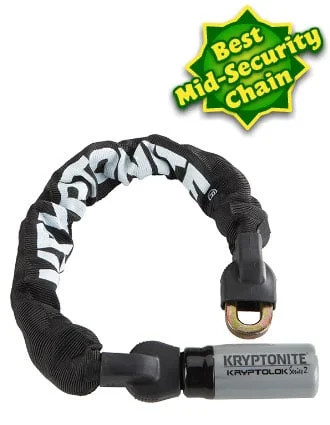 Kryptonite Krptolock Series 2 955 Mini best mid-security chain
Kryptonite Krptolock Series 2 955 Mini best mid-security chain
Kryptonite Kryptolok Series 2 955 Mini: Recognized as a top mid-security chain lock, ideal for cyclists needing a balance of security and portability.
| KryptoLok Series 2 955 Mini |
|---|
| My score: |
| Check price: |
| Chain thickness: |
| Weight: |
| Length: |
| Kryptonite rating: |
| Other Security Ratings: |
Keep the chain elevated off the ground to minimize vulnerability to bolt cutters. Wrapping it around the seat stays, as shown, is recommended. Alternatively, secure it around the top tube and use other methods to protect your wheels. For cyclists seeking a portable chain lock with enhanced locking versatility in moderate risk areas, the Kryptonite Kryptolok 955 Mini is a reliable and affordable option.
For a similar but more secure option, consider the Kryptonite Evolution Series 4 1055 Mini, featuring 10 mm links, a more robust body, and endorsed by the Lock Picking Lawyer. Read my hands-on review of the Kryptonite Kryptolok Series 2 955 Mini and explore more about chain locks if you’re unsure if this is the right type for you.
6. Litelok Core Plus: Wearable Bike Lock
One of the main challenges with bike locks is convenient transportation. Locks are often bulky and heavy, and frame mounts can be unsightly and unreliable. Larger locks, necessary for more locking options, exacerbate these issues. This is where “wearable” bike locks come into play. The Litelok Core Plus is currently the most secure “wearable” bike lock, achieving a Diamond rating from Sold Secure.
 Litelok Core around bike frame and back wheel
Litelok Core around bike frame and back wheel
Litelok Core Plus: Positioned as the strongest wearable bike lock, ideal for cyclists who prioritize high security and easy carry.
Liteloks are constructed from “Boaflexicore,” a complex cable composite, unlike typical cable locks. The Litelok Core Plus uses an upgraded Boaflexicore Plus, specifically designed to resist advanced cable cutters. It’s highly unlikely that anything other than an angle grinder can breach the Litelok Core. The most appealing feature of the Litelok Core Plus is its portability – it can be worn around your waist like a belt when not in use. While not the first wearable bike lock, like the Hiplok Gold chain, the Litelok Core Plus is superior in several aspects.
Firstly, it offers greater security. The Hiplok has a lower Sold Secure Gold rating and is vulnerable to bolt cutters, which are ineffective against the Litelok Core. Secondly, the Litelok is lighter and more comfortable to wear around the waist.
Litelok Core Plus: Highlights its awards and recognitions, affirming its status as a top-tier bike lock in security and design.
| Litelok Core Plus |
|---|
| My score: |
| Check price: |
| Waist Size |
| Weight: |
| Length: |
| Other Security Ratings: |
The Litelok Core Plus is not without its drawbacks. Threading the lock through wheel spokes can be awkward in certain situations. While available in two lengths, waist-worn use limits you to the size that fits. However, no other Diamond-rated lock is as easily portable. Even the smaller Litelok Core provides a generous locking circumference, offering numerous bike security options.
While waist-worn carry may not appeal to everyone (it can also be strapped to your frame), the Litelok Core Plus remains a highly secure and versatile choice. Read my full hands-on review of the Litelok Core Plus for more details.
How to Choose the Right Bike Lock for You
If none of the top 6 bike locks listed seem quite right for your needs, do not worry. Continue reading, and I will guide you through 3 straightforward steps that guarantee you will find the perfect lock for both you and your bicycle.
As previously mentioned, the best bike locks not only protect your bike but are also convenient for daily use. Your specific circumstances are crucial, including the type of bike you own, its value, how and where you use it, and your budget. Considering these factors might seem complex, but by following these 3 steps, the process becomes quite simple:
- Determine the appropriate security level.
- Choose the right type of lock.
- Select the correct lock size.
Step 1 focuses on identifying your required security level, and I will explain how to find locks that offer the necessary protection. Step 2 introduces various bike lock types and guides you in choosing the lock type that best suits your individual needs. Finally, Step 3 explains how to select the right size lock for your bike type and your preferred locking method.
Ready? Let’s begin!
Step 1: Determine the Right Security Level
The primary function of any bike lock is to prevent theft. Therefore, the first and most critical step is to determine the level of protection you need. However, simply choosing the strongest lock isn’t always the best approach. Increased security often means greater weight or reduced size, or both.
[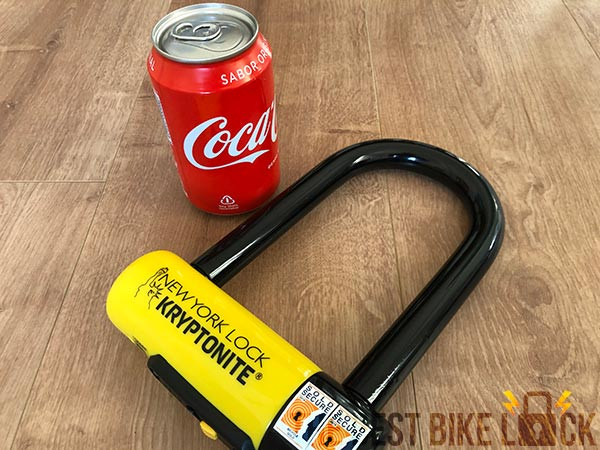 Kryptonite Fahgettaboudit Mini]
Kryptonite Fahgettaboudit Mini]
Kryptonite Fahgettaboudit Mini: A high-security bike lock known for its strength, though it is also notably small and heavy, which may limit usability.
Choosing an insufficiently secure lock puts your bike at risk of theft. Conversely, selecting an overly secure lock for your situation can lead to unnecessary inconvenience due to extra weight or limited size, without added benefit. This might deter you from using it consistently or correctly, still risking bike theft.
Therefore, matching the lock’s strength to your actual risk level is crucial. The easiest way to assess this is by answering the 3 questions in this quiz:
Take the bike lock security quiz
Based on your quiz results, you will receive a recommendation for a Sold Secure Silver, Gold or Diamond rated bike lock. You might be wondering, “Who or what is Sold Secure?”
Who is Sold Secure?
Sold Secure is an independent organization that rigorously tests and rates security products, including bike locks, based on their level of protection.
[]
Sold Secure ratings range from Bronze to Diamond, indicating increasing levels of bike security based on resistance to theft attempts.
Bike locks are rated Bronze (least secure), Silver, Gold, or Diamond (most secure), depending on their resistance to attack in the Sold Secure testing facility.
- Diamond locks: “provide the highest level of security … aimed at very high value bicycles and e-bikes.”
- Gold locks: “offer the next highest level of security, aimed at mid-to-high value bicycles.”
- Silver locks: “offer a compromise between security and cost.”
- Bronze locks: “typically offer defense against the opportunist thief.”
Why Trust Sold Secure Ratings?
Sold Secure conducts the most comprehensive bike lock testing and rating program. Their standardized tests employ tools and methods reflecting real-world theft techniques, including both brute force and lock picking. They collaborate closely with police and insurance companies to keep their methods current. Locks must be re-tested annually to maintain their rating.
[ The Sold Secure Lab]
The Sold Secure Lab]
Inside the Sold Secure workshop, where bike locks undergo rigorous testing to assess their security levels.
Most insurance companies require the use of a Sold Secure rated lock for bike insurance coverage, with the level of coverage often tied to the lock’s rating. Without a Sold Secure rated lock, insurance claims might be invalid. Therefore, Sold Secure ratings are highly trustworthy. They are experts in security assessment.
However, other metrics exist for evaluating bike lock strength, which should also be considered.
Other Independent Testing Organizations
Besides Sold Secure, ART in the Netherlands provides similar independent testing and rating services. ART rates locks on a scale of 1 to 5 (5 being the strongest), based on their resistance to attack.
[]
ART utilizes a 1-5 star rating system for bike locks, known for its stringent standards, though it rates fewer locks compared to Sold Secure.
ART employs both machine tests (tensile strength, torsion strength, cutting, corrosion, dust, and freeze tests) and engineer-led tests (brute force and intelligent attack tests) to determine ratings:
- 1 star: Minimum security (“take-away security”)
- 2 stars: For bicycles
- 3 stars: For mopeds and scooters
- 4 stars: For motorcycles (on the road)
- 5 stars: For motorcycles (parked at home)
Sold Secure vs ART Ratings
ART tests and rates fewer locks than Sold Secure, and their rating system is more focused. However, ART ratings can supplement Sold Secure ratings to provide a more detailed understanding of a lock’s security level. For example, if two locks both have a Sold Secure Gold rating, but one has a 2/5 star ART rating and the other has 3/5 stars, the latter is clearly more secure. This comparison is valuable for further differentiating security levels within Sold Secure ratings.
Online Bike Lock Tests: Use with Caution
Numerous cycling and product review websites publish articles detailing their bike lock attack tests using various tools to determine the “best” lock.
[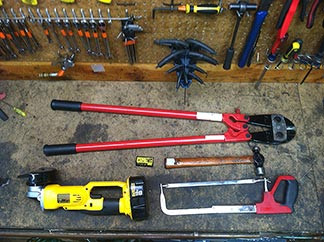 Lock testing tools]
Lock testing tools]
Tools commonly used in testing the security of bike locks, including cutting tools, leverage tools, and drills.
These articles can be entertaining, but their reliability is questionable for several reasons: They typically test few locks, lack standardized tools and methods, and may not replicate real-world theft techniques. A crucial point: defeating a lock with a tool not used by thieves is irrelevant. Thieves carry limited tool sets: cable cutters, medium bolt cutters, pry bars, and angle grinders. They do not use nut splitters or drills (anymore), and they do not pick locks!
Moreover, these online tests often overlook practicality issues like portability and ease of use, which are vital as there is no “one-size-fits-all” lock. Beyond the consensus that “all cable locks are rubbish” and “angle grinders cut through anything,” their conclusions are often uncertain and less useful. Many recommendations on prominent websites are demonstrably incorrect, undermining their credibility.
Bike Lock Brand Ratings: Often Confusing
Top bike lock brands have created their own rating systems to help consumers compare security levels within their product lines.
[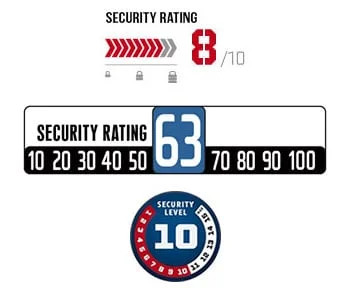 Different lock brand security ratings]
Different lock brand security ratings]
Security rating scales from different bike lock brands like Kryptonite, OnGuard, and Abus are shown side-by-side, illustrating the lack of standardization across brands.
While useful for comparing locks from a single manufacturer, these systems vary significantly, making cross-brand comparisons difficult.
How to Use Sold Secure Ratings Effectively
The most effective approach is to first determine your risk level using the quiz provided. If you are “high risk,” opt for a Gold or Diamond rated lock. For “lower risk” situations, a Silver rated lock is likely sufficient.
| Risk Level | Recommended Lock Security Rating |
|---|---|
| High Risk | |
| Lower Risk |
I generally advise against Sold Secure Bronze locks as they offer minimal practical protection. While potentially adequate in extremely low-risk areas, their vulnerability is too high for reliable security. Given the wide selection of locks at various sizes, weights, and prices, finding a Sold Secure Silver or better lock that fits your specific needs should be feasible.
Step 2: Choose the Right Type of Bike Lock
This step is nearly as important as determining the security level, as the lock type significantly impacts usability. A cumbersome lock is less likely to be used consistently, increasing theft risk. Avoid locks that are too heavy, too small, difficult to carry, complicated to use, or severely limit locking locations. The best type depends on individual needs, but understanding the pros and cons of each type is essential. There are four primary types of bike locks:
- U-locks
- Chain locks
- Folding locks
- Cable locks
Each type represents a compromise between:
- Price
- Practicality
- Security
[]
A chart comparing U-locks, Chain locks, Folding locks, and Cable locks across Price, Practicality, and Security, highlighting the trade-offs of each type.
Notice from the chart that u-locks, chain locks, and folding locks offer a reasonable balance of price, practicality, and security, while cable locks do not. Cable locks may be cheap and easy to use, but they offer very little security. Therefore:
Avoid cable locks.
To decide between the other types, let’s examine each in detail.
U-locks / D-locks
U-locks, or D-locks, function like large padlocks, securing bikes to stationary objects.
| U-locks: Pros and Cons |
|—|—|
| Pros | – More affordable than chain locks – Lighter than chain locks – More secure than folding locks |
| Cons | – Less portable – Limited reach for larger objects |
Good u-locks strike a balance between price, practicality, and security. They are generally more affordable, lighter, and slightly easier to use than chain locks while providing strong protection. Their rigid shape can make them less portable than chains, and their limited size restricts the objects they can secure to. However, for a single bike lock, a u-lock is generally recommended.
Prices range from around $30 / £18 for budget models to $300 / £300 for top-tier, highly secure models, offering options for various budgets. Consider size and portability carefully before purchasing. The top u-locks recommended earlier are standard-sized, versatile enough for most bikes and locking scenarios.
Smaller u-locks are also available and increasingly popular. Let’s look at a notable example:
Kryptonite New-U Evolution Mini-7
The Evolution Mini-7 is Wirecutter’s top pick and an excellent lock, but it’s not universally suitable.
[]
Kryptonite New-U Evolution Mini-7: A compact and high-security u-lock, favored for its robust design despite its smaller size.
| Kryptonite New-U Evolution Mini-7 |
|---|
| My score: |
| Check price: |
| Shackle thickness: |
| Weight: |
| Size (internal): |
| Kryptonite rating: |
| Other Security Ratings: |
The Mini-7 has many positives. Its 13 mm shackle is made from Kryptonite’s strongest “max performance” steel and locks into the crossbar on both sides, enhancing resistance to cutting and leverage attacks. This is reflected in its Gold Sold Secure rating. It includes a cable for securing the wheel not covered by the u-lock and a decent frame mount, if correctly installed. It is more secure than the Kryptonite Kryptolok and lighter than the Litelok X1 and many other Gold and Diamond rated locks, weighing less than 3 cans of soda without the cable.
[ Kryptonite Evolution Mini-7]
Kryptonite Evolution Mini-7]
Kryptonite Evolution Mini-7: Demonstrates its compact size and effective use for securing a bike frame and wheel to a fixed object.
However, remember a couple of key points: While Sold Secure Gold rated, it only received 2/5 stars from ART, placing it at the lower end of the Gold security spectrum. It is secure but not among the very best and offers no angle grinder resistance. Secondly, it is a mini u-lock, significantly narrower than standard u-locks, primarily suited for bike racks. Depending on your bike, it might limit locking options. For bikes with wider tires or thicker frames, fitting around the wheel, frame, and rack might be challenging.
However, with flexible locking techniques and strategies, you can use this lock to securely fasten almost any type of bike to a rack. While I appreciate this lock for my needs, its bike rack limitation makes it difficult to recommend universally. Read my complete review of the Kryptonite Evolution Mini-7 for further details.
Chain Locks
Chain locks typically consist of a metal chain covered in a protective sleeve and a robust padlock.
| Chain locks: Pros and Cons |
|—|—|
| Pros | – More portable than u-locks – More versatile locking to various objects |
| Cons | – Very heavy – More expensive |
Chain locks can be broadly categorized into:
- Portable Chains: Light enough for daily carry (< 12 mm thickness).
- Stationary Chains: Too heavy for portability, ideal for fixed locations (> 12 mm thickness).
Portable Chains
These are easily carried, wrapped around seat posts or in bags. Their length and flexibility allow securing bikes to diverse objects. However, chains under 12 mm thick are generally less secure than good u-locks and still considerably heavier.
Stationary Chains
Heavy-duty, core-hardened steel chains with high-quality padlocks offer maximum bike security. However, their weight makes them best suited as secondary, stationary locks at locations where bikes are regularly stored for extended periods. Chain lock prices range from about $45 / £40 for basic models to over $500 / £200 for heavy-duty options, generally more expensive than u-locks. Carefully consider size, thickness, and portability needs when choosing a chain lock.
The Kryptolok and Evolution chains recommended earlier are portable options. Now, let’s consider the best stationary chain lock:
The Strongest Static Chain Lock: Kryptonite New York Legend 1515
While Pragmasis may produce stronger chains, they are not globally available. The Kryptonite New York Legend Chain 1515 is the most secure, widely accessible bike chain lock.
[]
Kryptonite New York Legend 1515: Acclaimed as the best high-security chain lock, offering unparalleled protection for stationary bike security.
| New York Legend 1515 |
|---|
| My score: |
| Check price: |
| Chain thickness: |
| Weight: |
| Length: |
| Kryptonite rating: |
| Other Security Ratings: |
With 15 mm links, it is definitively not portable. This lock is designed to remain at your regular bike parking location, whether daily or overnight. It has earned a 5/5 ART rating, a rare achievement, and is available in 5′ and 3′ lengths, suitable for securing single or multiple bikes. For ultimate security in your bike shed or other bike storage solution, this is an excellent, though costly, option.
I have written a full review of the New York Legend Chain 1515 and compared it with other chain locks.
Folding Locks
Folding locks consist of hinged metal plates connected by rivets. They fold compactly for transport and unfold to secure bikes.
| Folding locks: Pros and Cons |
|—|—|
| Pros | – Most portable type – Versatile locking options – Relatively lightweight |
| Cons | – Limited selection – Durability concerns |
Generally, they are slightly heavier than u-locks of comparable security. Their flexibility and length offer more locking options than standard u-locks, and their compact folded form is ideal for easy transport. The carrying holster can attach via Velcro or bottle holder screws.
[]
Folding locks are truly compact and easy to carry, making them a practical choice for cyclists on the go.
Their compact design prevents loosening, swinging, or interfering with rides, issues sometimes encountered with u-locks. However, locking can be less straightforward than with u-locks or chains; unfolding and maneuvering them around the bike and object can be slightly cumbersome. Due to their complex construction, durability after attempted theft may be questionable. Despite this, folding locks are a great alternative if u-lock frame mounts are unsatisfactory.
Cable Locks: Not Recommended
Cable locks are made of braided steel strands inside a plastic tube.
[]
Kryptonite Cable lock: Depicts a typical cable lock, often chosen for its flexibility and low cost, but known for minimal security.
| Cable locks: Pros and Cons |
|—|—|
| Pros | – Long – Light – Affordable – Convenient |
| Cons | – Bike theft is almost guaranteed |
They are light, flexible, and inexpensive. However, their flexibility also makes them easily cuttable with handheld cable or bolt cutters in seconds. Since cable cutters are a common tool among bike thieves, cable locks offer minimal practical security. Thieves specifically target cable locks, and statistics suggest that a large percentage of stolen bikes were secured with them.
By avoiding cable locks, you significantly reduce your bike theft risk. Cable locks can serve as secondary locks for wheels or saddles, but there are better alternatives for component security.
Innovative Bike Locks
A final category is innovative locks, often from independent creators and crowdfunded through platforms like Kickstarter.
| Innovative locks: Pros and Cons |
|—|—|
| Pros | – Address shortcomings of traditional locks – Utilize new technologies |
| Cons | – Expensive – Largely untested |
Many innovative locks lack proven security credentials, often missing Sold Secure or ART ratings. However, some tested and rated models are noteworthy, like the titanium TiGr Mini and textile Tex-lock. These innovative locks tend to be pricier relative to their security level and should be considered primarily for addressing specific usability issues not met by standard locks.
U-locks vs Chain locks vs Folding locks: Which to Choose?
[]
A visual comparison of U-locks, Chain locks, and Folding locks, illustrating their typical shapes, sizes, and mechanisms.
For a more detailed comparison, see my u-lock vs chain lock page. In summary:
Portable Security
For everyday carry, u-locks are generally the best choice. They offer a superior balance of security, practicality, and price compared to portable chains, being lighter, more affordable, and more secure.
[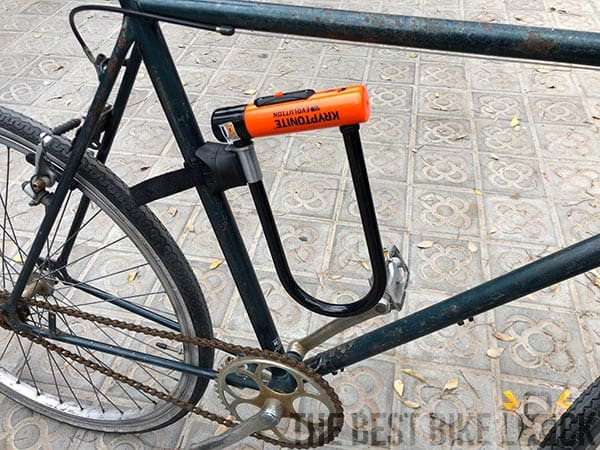 Kryptonite Evolution Standard]
Kryptonite Evolution Standard]
Kryptonite Evolution Standard: A U-lock shown mounted on a bike frame, highlighting its suitability for portable bike security.
While chains might be preferred for more locking options or if u-lock mounts are disliked, u-locks are typically the best portable security solution.
Stationary Security
For fixed locations like home or work, heavy chains are preferable. Thick chains with strong padlocks provide the highest level of security.
[ High security chain with ground anchor]
High security chain with ground anchor]
High security chain locks are shown used with a ground anchor, illustrating their effectiveness for stationary security at home or work.
They resist power tools better, are bolt-cutter proof (16 mm+), and immune to bottle jack attacks. Chains can secure multiple bikes and work well with ground anchors. However, they are not practical for carrying around.
Folding Locks: A Balanced Alternative?
Folding locks, like u-locks, are best for mobile security, addressing u-lock limitations in shape and portability. Their flexibility offers more locking options, and their compactness improves transport. They compete with u-locks in weight, often slightly heavier, but high-security folding locks are less secure and more expensive than high-security u-locks. Choice is also limited to brands like Abus, Seatylock, Trelock, and Kryptonite.
[]
Abus Bordo Granit X Plus 6500: A folding lock shown mounted on a bike, illustrating its portability and convenience for cyclists.
However, if u-locks don’t meet your needs, consider a folding lock before a chain lock for portable security.
Step 3: Choose the Right Lock Size
Once you’ve determined the necessary security level and lock type, size is the next crucial factor. Lock size greatly influences usability. Ideally, smaller, lightweight bike locks are preferred, suitable for slim road bikes or single-speeds in areas with ample bike racks. However, bulkier bikes like ebikes, mountain bikes, or cruisers, or locations lacking bike racks requiring use of lamp posts or railings, necessitate larger locks.
Bike locking technique also plays a role. Traditional wisdom suggests securing both frame and rear wheel, requiring a larger lock. However, alternative wheel security methods exist, allowing frame-only locking with smaller locks, even on larger bikes. Consider your locking strategy before choosing a lock size.
Generally, larger bikes (ebikes, mountain bikes, cruisers, city bikes, comfort bikes, tandems, BMXs) need locks with a locking circumference at least as large as a standard u-lock (around 85 cm). Slender bikes (road bikes, hybrid bikes, fixies/single-speeds) can often use mini u-locks and smaller folding locks. However, personal circumstances vary greatly, so careful consideration is essential.
Which Company Makes the Best Bike Locks?
After deciding on security level, lock type, and size, you’ll likely encounter many similar bike locks from various brands. How do you choose between them? Let’s compare three popular brands: Abus, Kryptonite, and OnGuard.
Abus vs Kryptonite vs OnGuard
For a detailed comparison, see my Abus vs Kryptonite vs OnGuard page, including a review of their “Anti-theft Protection” schemes. Here’s a quick summary:
[]
A comparative graphic of Abus, OnGuard, and Kryptonite bike lock brands, highlighting their key strengths in quality, price, and customer service.
Abus offers the highest quality locks, known for excellent build, rigorous testing, reliability in all conditions, and longevity. However, they are the most expensive. Kryptonite also produces high-quality locks, slightly below Abus in standard but compensated by exceptional customer service, including free key and lock replacements and superior anti-theft protection schemes. OnGuard has improved lock quality significantly recently and offers the best prices, though with a slightly lower reputation for build quality and customer service compared to Abus and Kryptonite. Choose Abus for top quality, OnGuard for best price, and Kryptonite for best customer service.
Other Reputable Bike Lock Brands
While Abus, Kryptonite, and OnGuard are well-known, many other brands deserve consideration. In fact, in 2024, my top 6 picks feature more niche brands than established ones, including two locks each from Litelok and Seatylock (Foldylocks).
[ The Hiplok attached to my belt]
The Hiplok attached to my belt]
Hiplok: Showcasing a wearable bike lock design, attached to a cyclist’s belt for easy and secure transport while riding.
Hiplok specializes in wearable bike locks, from waist-worn chains to belt-clipped u-locks, simplifying lock transport. Smaller brands are driving key innovations, and larger brands are expected to catch up.
Making the Final Decision
Following these three steps should guide you to the ideal security level, lock type, size, and brand. If none of my top 6 recommendations are suitable, browse comprehensive lists of Sold Secure Silver, Gold, or Diamond bike locks based on your risk level, comparing sizes, weights, and prices to find your perfect match.
How Much Should You Spend?
Generally, higher spending equates to better lock quality, primarily in terms of reliability. Reliability is crucial for bike locks. Avoid locks with keys that fail, mechanisms that jam, or shackles that stick, which can cause significant issues.
[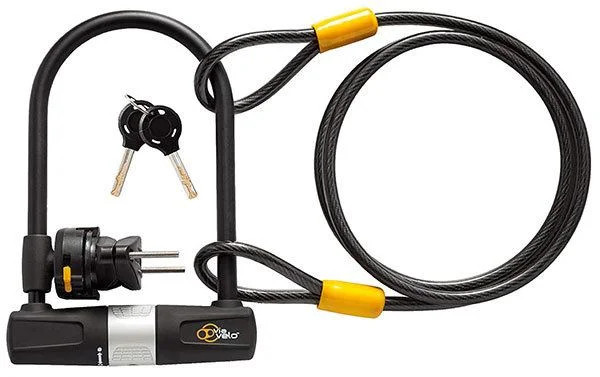 Cheap u-lock]
Cheap u-lock]
Cheap u-locks can be secure but are often unreliable, with customer reviews often highlighting issues with durability and mechanism failures.
Locks malfunctioning while secured can immobilize your bike, requiring professional removal. Malfunctions before securing can lead to theft. Higher quality locks are less prone to these issues. While some affordable, high-security locks exist, and expensive, low-security locks also exist, high-security locks generally cost more, and reliable, high-security locks always cost more.
[ How much money should I spend?]
How much money should I spend?]
A visual guide suggesting how much to invest in a bike lock, advising spending as much as affordable for better security and peace of mind.
Many brands suggest spending 10% of your bike’s value on a lock. However, for a $200 bike, a $20 lock is likely insufficient. Spend as much as you can afford for better reliability, security, and peace of mind. A good bike lock can last for years and across multiple bikes, making it a worthwhile investment, especially if you plan to upgrade your bike in the future. While buying a bike lock may not be exciting, and spending money on security can be frustrating, a cheap lock is false economy. A malfunctioning lock can lead to costly removal or bike theft, requiring replacement of both the lock and bike. Learn from others’ mistakes and invest wisely from the start.
Frequently Asked Questions About Bike Locks
This final section addresses common questions about bike locks, providing additional insights to aid your decision-making.
Do Bike Thieves Use Lock Picking Techniques?
No, most bike thieves lack lock picking skills and tools. Basic bike locks are easily defeated by brute force, making picking unnecessary for most thefts. While a few thieves might have basic lock raking tools, their skills are usually limited, posing minimal threat to decent locks. Expert lock pickers like Bosnian Bill and the Lock Picking Lawyer use specialized tools in controlled environments. Their ability to quickly open locks does not translate to street theft scenarios.
While the Lock Picking Lawyer can open even good locks quickly in videos, as he notes, they still offer “enough pick resistance to use in the street” because typical street thieves lack his tools and expertise.
Understanding lock mechanisms is helpful when choosing a bike lock. Four common types are disc detainer, slider, pin tumbler, and wafer mechanisms. Disc detainer mechanisms, pioneered by Abloy and used in high-quality locks like Abus and Kryptonite, are durable and generally pick-resistant. Slider mechanisms, often with keys featuring straight edges and internal teeth, are used by budget brands like OnGuard and Zefal and vary in pick resistance depending on implementation. Pin tumbler and wafer mechanisms are generally less secure, more vulnerable to raking attacks, with wafer mechanisms being particularly easy to open and best avoided.
What is the Strongest Bike Lock?
The strongest bike locks are the Litelok X3 and Hiplok D1000. In my tests, the Litelok X3 slightly outperformed the Hiplok D1000 in angle grinder resistance. Both offer exceptional resistance, almost “angle grinder proof” in real-world scenarios. However, these locks are heavy and expensive. A more practical option for many cyclists is the Litelok X1, which, while slightly less grinder-resistant, is still far stronger than other locks and is lighter, better sized, and more affordable, with a frame mount included.
[ Kryptonite Fahgettaboudit Mini]
Kryptonite Fahgettaboudit Mini]
Litelok X1: Highlighted as nearly angle grinder proof, offering exceptional resistance to one of the most aggressive bike theft tools.
See my Litelok X1 review for details and angle grinder test video. I have also written a full article on the strongest bike locks. Remember, increased lock strength often means increased weight or reduced size, or both.
What is the Lightest Bike Lock?
The lightest bike lock I recommend is the TiGr Mini. However, lightweight locks often compromise security or size, or are very expensive. “Lightweight” is subjective for bike locks.
[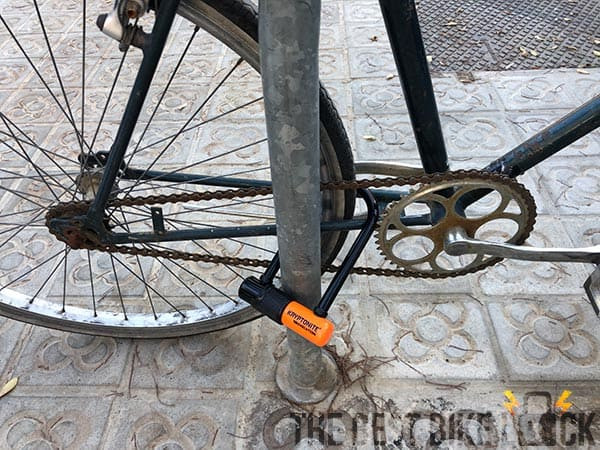 Kryptonite Evolution LITE Mini-6]
Kryptonite Evolution LITE Mini-6]
Kryptonite Evolution LITE Mini-6: Advertised as a lightweight bike lock, weighing less than two cans of soda, emphasizing portability.
Carefully compare weight, size, price, and security ratings when considering lightweight locks to ensure the trade-offs are acceptable. I’ve written an article on the lightest bike locks to guide you.
How Can I Protect My Bike Wheels and Seat?
Bike wheels and seats can be secured using extra locks, cable lassos, security skewers, hex bolt blockers, and DIY methods.
[ Hexlox wheel skewer]
Hexlox wheel skewer]
Hexlox wheel skewer: An example of anti-theft wheel security, designed to prevent quick removal of bike wheels by thieves.
My article on securing bike wheels and seats covers available options in detail.
What’s the Best Way to Lock My Bike?
There is no single “best” way to lock a bike, but many “bad” methods guarantee theft. My comprehensive article on how to lock a bike covers both secure and insecure methods. Reading this before choosing a lock is advisable.
[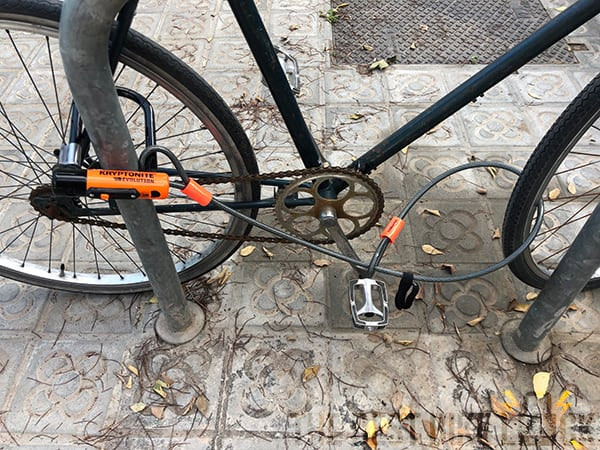 Secure bike locking methods]
Secure bike locking methods]
Illustrates secure bike locking methods, emphasizing proper techniques to maximize bike security and theft prevention.
Learning secure locking techniques, including potentially lesser-known methods, can help you choose a more user-friendly, possibly smaller and lighter lock.
This page contains affiliate links, which means I may earn a small commission if you click through and make a purchase. You will not pay any extra. More details here.
Further Reading:
Sold Secure Gold Bike Locks: The Complete List
Win a Free Bike! Competition
How to Lock Your Bike Properly

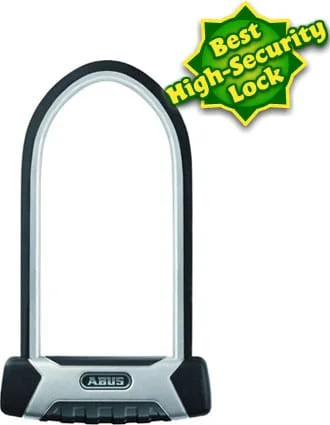 Litelok X1: Best Bike Lock
Litelok X1: Best Bike Lock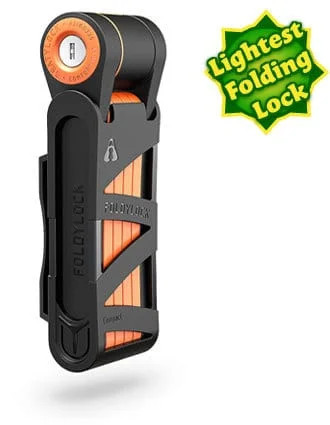 Foldylock Compact
Foldylock Compact Foldylock Forever
Foldylock Forever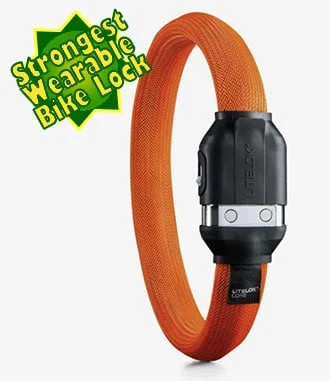 Litelok Core
Litelok Core